Parker's Philosophy
Today, a book straddles an intellectual divide. The University of Houston's College of Engineering presents this series about the machines that make our civilization run, and the people whose ingenuity created them.
This 1871 edition of A School Compendium of Natural and Experimental Philosophy still reflects the old ways of its original 1848 author, Richard Parker. When Parker died, civil engineering professor George Plympton set out to revise the book. By 1871, Americans no longer spoke of natural philosophy. They'd replaced it with the fancy French term physics (or physique). But Plympton kept the old title.
Revising Parker's clear and articulate book had to be a daunting task. Parker had provided fine pedagogy. But he'd done so on the eve of a revolution in physics. Plympton was a practical man, but he also was imaginative and up-to-date on new currents in science. So how did he handle such a tricky revision? He tells us:
The revision ... has led to such corrections [as] recent progress in physical science demanded ... without changing the numbering of paragraphs or [pages.]
But then he adds a fine 42-page Appendix, where he lays out new ideas about pneumatics, optics, thermodynamics and machinery -- as well as creative ways of teaching them.
When Parker wrote the original book, scientists still saw heat as the old alchemical fluid they'd called caloric. That's gone in Plympton's revision. Parker had also referred to the study of heat as pyronomics. There's a wonderful word. It means something like the rules of fire. Plympton leaves that word in, but he goes on to explain that heat is a manifestation of molecular agitation.
He also leaves Parker's two Latin aphorisms on the title page. One of them, from Horace, says, Delectando pariter que monendo. It means, To please while instructing. And, as I look through these clean illustrated pages, I am certainly pleased.
The other aphorism is a wise suggestion: Prodesse quam conspici. It means, Be productive rather than conspicuous. And that very nicely fits Plympton, the book's reviser.
Plympton did everything. He taught at several universities and he directed Cooper Union's night schools. He edited the Engineer's Magazine, devised water supply and sewages systems for Bergen, New Jersey, revised other textbooks, and translated several works from French into English. He was even given an MD degree by the Long Island College Hospital.
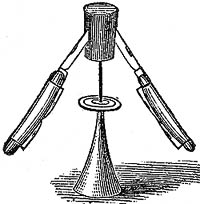 Parker originally wrote his textbook in question-and-answer style. Plympton kept that. He realized that learning occurs only when students asks questions. That's something that many current textbooks forget. Instead of salting questions, they explain until the student is numb. Here, the lean prose and clean line drawings are beautifully tuned to any reader's rising curiosity.
Parker originally wrote his textbook in question-and-answer style. Plympton kept that. He realized that learning occurs only when students asks questions. That's something that many current textbooks forget. Instead of salting questions, they explain until the student is numb. Here, the lean prose and clean line drawings are beautifully tuned to any reader's rising curiosity.
I especially love the purity of those drawings -- stable and unstable toys, water turbines and electromagnetic relays, galaxies and steam engines. And I think delectando pariter que monendo indeed. This is pleasing instruction if I've ever seen it.
I'm John Lienhard, at the University of Houston, where we're interested in the way inventive minds work.
(Theme music)
R. G. Parker, A School Compendium of Natural and Experimental Philosophy. (revised by G. W. Plympton) (New York: Collins & Brother Publishers, 1871). First published in 1848.
A thumbnail biography of Plympton may be found in the Cyclopaedia of American Biography.
My thanks to Jeff Fadell, UH Library, for his help with Latin translations and etymology.
All images from Parker's book. The one in the text illustrates a stable system.

Illustration of the lever principle
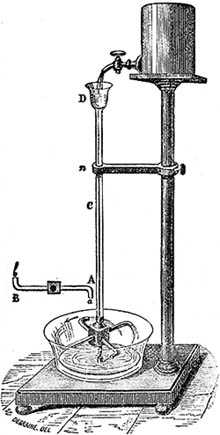
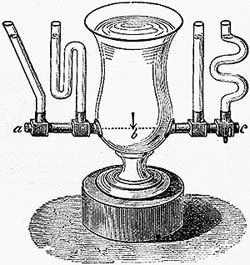
Impulse turbine on left. Illustration of the related principle of hydrostatic pressure on the right.
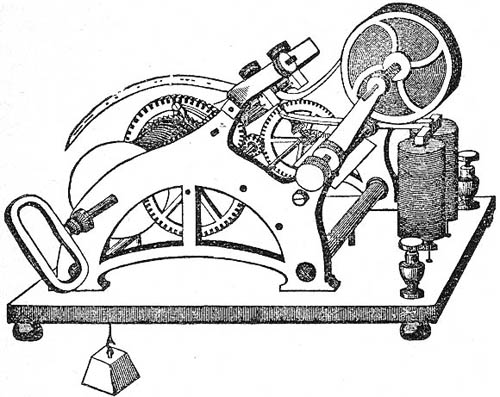
Electromagnetic telegraph
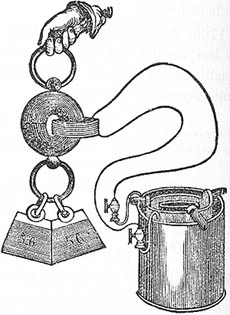
An interesting application of electromagnetism